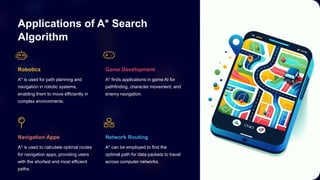potential development of the A* search algorithm specifically
- 1. Introduction to A* Search Algorithm The A* search algorithm is a widely used pathfinding algorithm. It efficiently finds the shortest path between two points in a graph or grid by combining heuristics and cost calculations. ss by sitohang
- 2. Strengths of A* Search Algorithm 1 Optimal Path A* guarantees finding the shortest path if the heuristic function is admissible. It finds the most efficient route by considering both distance and estimated cost. 2 Informed Search A* uses heuristics to guide the search towards promising paths. This reduces the search space and speeds up the pathfinding process. 3 Dynamic Environments A* is adaptable to dynamic environments where obstacles or costs can change during the search. It can dynamically adjust the path to account for these changes. 4 Wide Applicability A* finds applications in various domains, including robotics, game development, navigation, and logistics.
- 3. Weaknesses of A* Search Algorithm Heuristic Dependence The quality of the heuristic function significantly influences the performance of A*. A poorly chosen heuristic can lead to suboptimal paths or inefficient searches. Memory Requirements A* maintains a list of open and closed nodes, which can consume significant memory, especially in complex environments with large search spaces. Computational Complexity In worst-case scenarios, A* can exhibit exponential complexity, making it computationally expensive for large graphs or grids.
- 4. Opportunities for A* Search Algorithm Hybrid Approaches Combining A* with other pathfinding algorithms, such as Dijkstra's algorithm, can leverage their strengths to enhance performance in specific situations. Improved Heuristics Developing more accurate and efficient heuristic functions can significantly improve the speed and accuracy of A* in various applications. Parallel and Distributed Search Implementing A* in a parallel or distributed manner can accelerate the search process, especially for large and complex graphs. Real-Time Applications With advancements in computing power, A* is becoming increasingly feasible for real- time applications, such as autonomous navigation and robotics.
- 5. Threats to A* Search Algorithm Limited Memory Resource constraints, such as limited memory, can significantly impact the performance of A* in resource-intensive applications. Dynamic Environments Rapidly changing environments can pose challenges for A* as it needs to adapt to new information and obstacles in real time. Computational Complexity For very large or complex graphs, A* can become computationally expensive, hindering its applicability in real-time applications. Heuristic Design Designing accurate and efficient heuristics remains a challenge, and inappropriate heuristics can lead to suboptimal paths or inefficient searches.
- 6. Comparison to Other Pathfinding Algorithms A* Search A* is an informed search algorithm that uses heuristics to guide the search towards the most promising paths. It aims to find the shortest path efficiently. Dijkstra's Algorithm Dijkstra's algorithm is an uninformed search algorithm that finds the shortest path by exploring all possible paths from the starting node. It is less efficient than A* for large graphs. Breadth-First Search Breadth-first search explores the graph level by level, finding the shortest path in terms of the number of edges traversed. It is less efficient than A* for complex graphs.
- 7. Applications of A* Search Algorithm Robotics A* is used for path planning and navigation in robotic systems, enabling them to move efficiently in complex environments. Game Development A* finds applications in game AI for pathfinding, character movement, and enemy navigation. Navigation Apps A* is used to calculate optimal routes for navigation apps, providing users with the shortest and most efficient paths. Network Routing A* can be employed to find the optimal path for data packets to travel across computer networks.
- 8. Conclusion and Future Considerations The A* search algorithm remains a valuable tool for pathfinding and optimization in diverse applications. Its strengths, combined with continuous advancements in heuristic design and computational power, will likely drive further development and applications.







